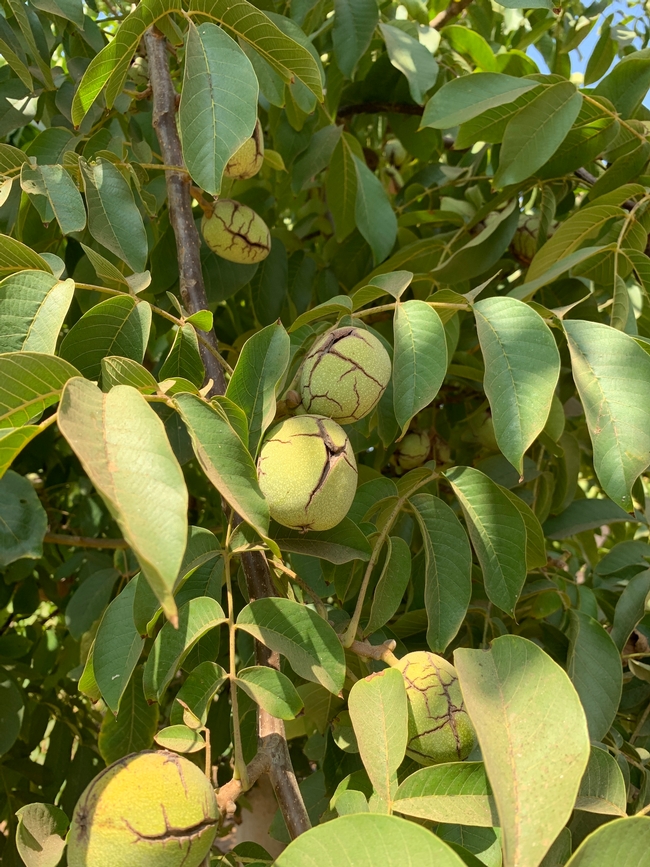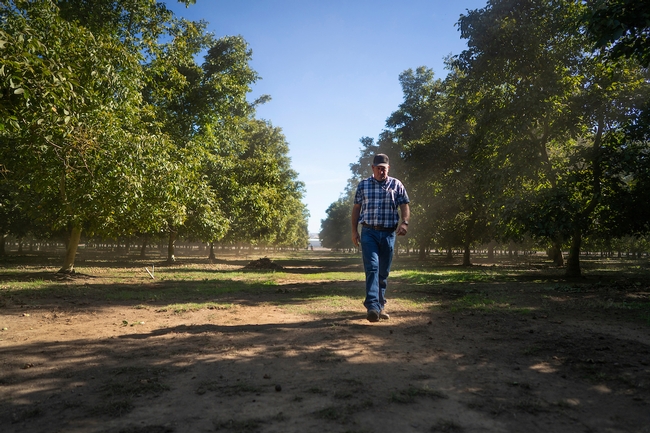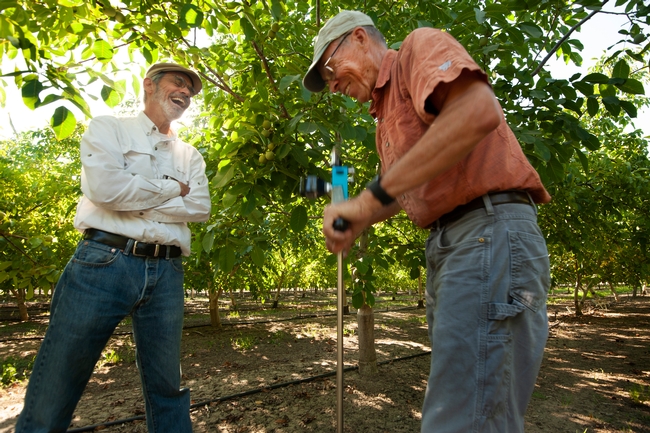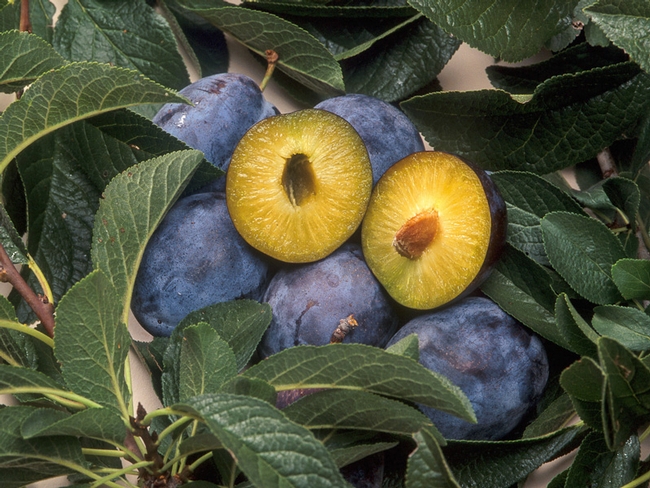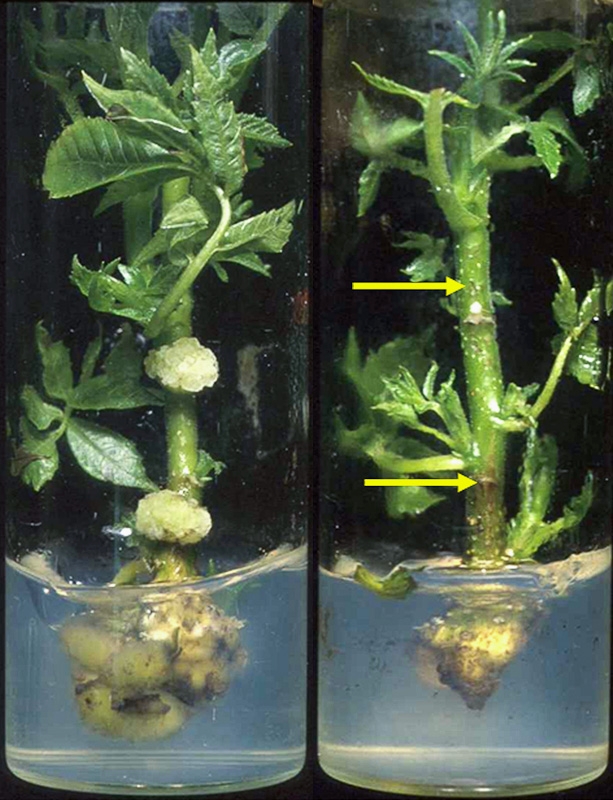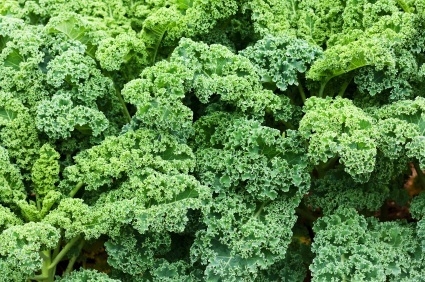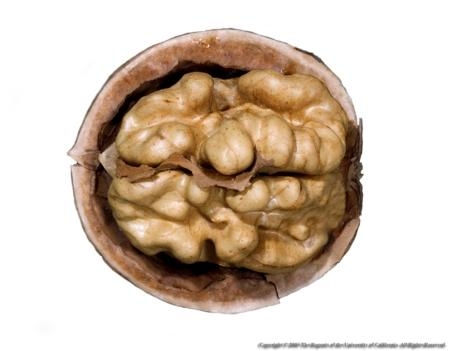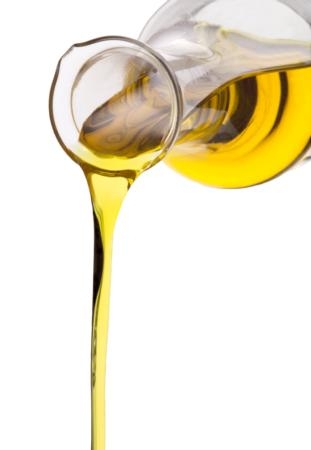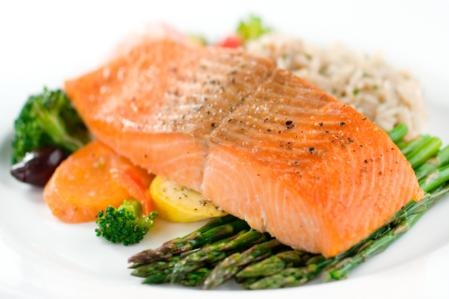Posts Tagged: Walnuts
‘UC Wolfskill’ walnut will allow earlier harvest
UC Davis researchers have bred a new walnut variety designed to provide growers a way to harvest earlier and boost the harvest efficiency of California's $1.6 billion walnut industry.
The new “UC Wolfskill” walnut has yield, quality and light color similar to Chandler, which is a late-harvesting walnut and the state's leading variety. UC Wolfskill was bred in 2003 from a cross of Chandler with the Solano walnut. UC Wolfskill combines the color and shell traits of Chandler with the earlier harvest date and kernel fill of Solano.
“The release of UC Wolfskill means growers can spread out their harvest and still have a really high-quality nut that will fetch top-notch prices and provide similar yields,” said Pat J. Brown, breeder and professor with the UC Davis Department of Plant Sciences.
Over 99 percent of the nation's walnuts are grown in California. More than half of the state's bearing acres are the late-harvest Chandler walnuts.
“The California walnut industry needs earlier harvesting walnut varieties to provide efficient use of harvesting, drying and processing equipment,” said breeder Chuck Leslie, with the UC Davis Walnut Improvement Program. “UC Wolfskill can be harvested 12 to 14 days earlier than Chandler and provides consistently light to extra light color.”
Handlers judge the value of a walnut based on its color and how well it halves while processing. In blind quality evaluations by commercial graders, the UC Wolfskill was often not distinguished from Chandler.
UC Wolfskill was originally planted and evaluated at UC Davis, and field trials with growers began in 2011.
“The commitment of our walnut growers, as collaborators, is the foundation that makes this release possible. The Board is extremely grateful for the long-term partnership of our growers and the UC, in finding innovative solutions that help us solve for critical needs,” said Michelle Connelly, executive director of the California Walnut Board.
The California Walnut Board funded the research. UC Wolfskill is currently available to California nurseries for propagation in California and sales to growers throughout the United States. Nurseries interested in propagating and selling this cultivar may obtain a license from UC Davis InnovationAccess.
A nutty idea: A little stress could be good for walnuts
When it comes to watering walnuts, most California growers believe you need to start early to keep trees healthy and productive throughout the long, hot summer. But according to striking results from a long-term experiment in a walnut orchard in Red Bluff, growers can improve crop production if they hold off irrigation until later in the season and directly measure their trees' water needs.
The findings from researchers at the University of California may help farmers optimize water use.
“It's a game-changer,” said walnut grower Hal Crain, who welcomed researchers on to his orchard to test irrigation optimization. “It's clear to me you can improve nut quality and yield by applying water based on what the tree wants and needs, rather than just watering when it's hot outside and the soil is dry. That's a big deal for walnut growers and for the entire agricultural industry.”
Changing the paradigm
Crain is a second-generation farmer whose family has been growing walnuts in Butte and Tehama counties for 55 years. Like most walnut farmers, Crain had always started irrigating in early to mid-May when the days grew warmer and the trees sprouted leaves.
“That's standard practice for probably 90 percent of California's walnut growers,” said Crain, walking amid his trees on a sunny afternoon. “The theory is that when you irrigate early, you preserve the deep moisture in the soil that trees need to survive the heat of summer.”
But that's not how it works, the research shows. Instead, trees that grow in saturated soil early in the season don't develop the deep roots they need to thrive.
“With all the water right there at the surface, the lower roots suffer,” explained Bruce Lampinen, UC Cooperative Extension orchard management specialist with the UC Davis Department of Plant Sciences. “Trees end up with a very shallow root system, which doesn't serve them well as they try to extract moisture from the soil later on.”
Lampinen has long suspected that walnuts were getting too much water in the spring.
“A lot of the symptoms we see like yellowing leaves and various diseases can all be explained by overwatering,” said Lampinen.
So Lampinen did what scientists do: He set up an experiment. Five years ago, with funding from the California Walnut Board and the U.S. Department of Agriculture, he joined forces with Ken Shackel, a plant sciences professor with UC Davis, and Allan Fulton, an irrigation adviser with UC Cooperative Extension. Together, they led a team of scientists testing irrigation on Crain's ranch.
“Hal is an exceptional partner,” Fulton said. “Farmers have a lot to accommodate when they host an experiment like this, with researchers going in and out of the orchard at all hours. He had to work around our people and the timing of our water treatments. He's always eager to experiment with technology and learn new things, and he shares what he learns with other growers. Hal completes the circle.”
Tough nut to crack
When is the best time to irrigate? Researchers say the trees hold the answer. Scientists use pressure chambers, which are air-pressure devices that measure a leaf or small shoot to gauge how hard the plant is working to pull moisture from the soil.
“Just because the soil looks dry doesn't mean the plant is suffering,” said Shackel, who specializes in plant physiology. “Pressure chambers let you ask the tree how it's feeling — sort of like taking a human's blood pressure — which is a much more accurate way to measure a plant's water needs.”
For the last five years, the team has been applying different water treatments to five blocks of trees. One block is getting standard, early irrigation. Crain's orchard managers begin irrigating the other blocks when the trees reach different levels of water stress based on pressure-chamber readings.
The trees that experience moderate stress are doing the best. Their irrigation usually starts in mid-to-late June, several weeks later than when standard watering begins.
“You can tell just by looking at that block that the trees are healthier,” said Crain, standing beneath a canopy of lush, green trees. “And, we're starting to see greater yields and better nut quality.”
Translating the research
The research is helping scientists advise farmers on irrigation.
“My biggest take-away is knowing when to start watering is a really important factor to the health of your trees,” Lampinen says.
Pressure chambers — sometimes called pressure bombs — can cost more than $3,000, and high-tech versions are under development.
“I tell growers a pressure bomb would pay for itself even if you just used it once a year to determine when to start watering,” Lampinen said.
Crain is certainly convinced.
“When you irrigate based on your trees' needs, you optimize water,” Crain says. “I'm not using less water overall, but the water I do use is producing more food. That's good news for everyone.”
This story was originally published in the Fall 2018 issue of Outlook Magazine, the alumni magazine for the UC Davis College of Agricultural and Environmental Sciences.
Genetic engineering for roots — not fruits
Even though U.S. consumers routinely buy and eat genetically engineered corn and soy in processed foods — most are unaware of the fact because the GE ingredients are not labeled.
When consumers are asked in surveys whether they would buy genetically engineered (GE) produce such as fruit, most say they would not buy GE produce unless there were a direct benefit to them, such as greater nutritional value.
Yet with continuing invasions and spread of exotic insects and diseases for which there is no known control, the potential importance of trees or vines with some form of genetically engineered resistance is on the rise. In California, such diseases include Pierce's disease in grapes, crown gall disease in walnuts, and the invasive citrus greening (huanglongbing or HLB) in citrus.
"These are potentially devastating diseases to California growers, who produce 70 percent of the fresh fruit and nuts for the entire United States," notes Victor Haroldsen, scientific analyst at Morrison and Foerster, in the current California Agriculture. "They are also a mainstay of the California economy. Fruit and nut tree crops accounted for one-third of the state's total cash farm receipts, or $13.2 billion in 2010."
Now, however, Haroldsen reports that there may be a way to satisfy both consumers and growers — called "transgrafting."
"In transgrafting the genetically engineered rootstock can potentially confer the whole plant with resistance to disease. Yet the rootstock does not transfer the modified genes to the fruits or nuts produced," said Haroldsen.
Although over 10 years old, transgrafting technology is just now nearing commercialization, partly due to the long generation times of most trees and vines. Two such transgrafting applications are: a crown gall-resistant walnut rootstock, and a grape rootstock that confers moderate resistance to Pierce's disease.
"The key advantage of transgrafting is that the plant's vascular system can selectively transport across graft junctions the proteins, hormones, metabolites and vitamins from the roots without changing the heritable genes or DNA sequence in the fruit or nut." says Haroldsen.
In recent research at UC Davis, Haroldsen (a former graduate student) and his colleagues confirmed that modified DNA and full-length RNA from the rootstock does not cross the "graft union" into the scion, in the walnut and grape applications, or in a tomato model of these two systems.
"These current GE applications address root or xylem pests and diseases, but future applications will likely target traits aimed at consumer needs such as increased nutritional value or improved flavor," said Haroldsen. "If perceived risks to personal health and the environment could be reduced, genetic engineering could benefit not only growers but Californians around the state," he adds.
New findings on benefits of “biofactors” in food
Can what we eat help fix what ails us? Research increasingly suggests the answer is “yes.” Many foods contain biofactors — biologically active compounds — that may prevent and treat illnesses including asthma, diabetes and heart disease, according to new studies from the UC Davis Center for Health and Nutrition Research (CHNR).
The upcoming July-September California Agriculture journal (to be posted by July 11) reports UC research into plant compounds (phytochemicals) that can help prevent or treat disease. The findings stem from pilot projects at the center, as well as other UC research. Articles focus on how micronutrients, biofactors and phytochemicals (plant compounds) can help reduce the risk of chronic diseases.
Biofactors are compounds in our food that affect us at the biochemical level and may ultimately benefit our health. For example, the omega-3 fatty acids in foods such as walnuts, flax seeds, kale and salmon may protect against a range of diseases associated with inflammation, including asthma and the hypertension-related inflammation that can damage kidneys. CHNR research suggests that omega-3 fatty acids could reduce asthma symptoms as well as kidney damage.
Phytochemicals and health. Epidemiological studies link particular diets to less risk of chronic diseases. Notably, the traditional Mediterranean diet — mostly vegetables, fruits and whole grains, with moderate amounts of nuts, olive oil and red wine — is associated with lower rates of heart disease, cancer, and Parkinson's and Alzheimer's diseases. However, it has yet to be firmly established that specific phytochemicals in our diets can protect against diseases. Nutritionists therefore advise eating a wide variety of plant-based foods rather than taking supplements.
That said, a number of phytochemicals do show promise in protecting against and even treating chronic diseases. For example, research shows that soybeans contain estrogen-like compounds called isoflavones that may protect against heart disease, and that compounds in olive oil and red wine may protect against heart disease and diabetes.
Mitochondrial nutrients and aging. The Mediterranean diet is rich in plant compounds that boost mitochondria (organelles in our cells that convert glucose and other nutrients into energy) and so are known as mitochondrial nutrients. When mitochondria are scarce or have genetic defects that keep them from working properly, this can generate toxic metabolites and damaging free radicals.
“Mitochondria are central to aging,” says UC Irvine aging expert Edward Sharman. “Improving their function may modulate or delay the onset of diseases related to aging, such as type 2 diabetes and age-related macular degeneration.” Mitochondrial dysfunction also plays a key role in chronic illnesses such as heart disease, type 2 diabetes and inflammatory diseases such as arthritis.
One of the most promising mitochondrial nutrients is hydroxytyrosol, which is abundant in the extra-virgin olive oil that provides most of the fat in the traditional Mediterranean diet. Moreover, the red wine that is integral to the Mediterranean diet also induces the body to produce more hydroxytyrosol.
A new essential nutrient? Another promising mitochondrial nutrient is pyrroloquinoline quinone (PQQ), which was first found in nitrogen-fixing soil bacteria and is now known to be ubiquitous.
“We’re exposed to PQQ all the time at low levels,” says CHNR co-director Robert Rucker, a UC Davis nutrition professor. “It can be derived from amino acids found in stellar dust, and stellar dust is what the earth is made of.”
While Escherichia coli and other common gut bacteria do not make PQQ, the soil bacteria provide it to the plants in our diet. Good sources include fermented soybeans, wine, tea and cocoa.
Animal studies show that PQQ affects health markedly. Rucker and his colleagues found that depriving rats of PQQ compromised their immune systems, and retarded their growth and reproductive rates. In contrast, restoring PQQ to their diets reversed these effects and returned them to good health. Moreover, PQQ stimulated nerve growth and counteracted aging in cultured cells.
Rucker and his colleagues found that, like hydroxytyrosol, PQQ increases the number of mitochondria in cells. “It’s also an extremely good antioxidant and anti-inflammatory agent,” he says.
Personalized medicine. Understanding what biofactors do in our bodies could ultimately lead to personalized medicine, where nutrition-based treatments are tailored to the particulars of each person’s biochemistry. This individual variation at the biochemical level may help explain the inconsistent outcomes of research on omega-3 fatty acids and inflammation.
“The studies are mixed,” says UC Davis pulmonologist Nicolas Kenyon. “Some have shown little effect and others have shown that omega-3 fatty acids can reduce arthritis and inflammation in blood vessels.”
This genotyping is targeted to DNA sequences associated with asthma and so is not comprehensive.
“Some people are nervous about genome-wide analysis, which is scary because none of us is perfect,” Kenyon says. “But people are more interested when the focus is specific screening that could increase their chances of treatment.”
Nuts contribute protein, fiber and healthy fat to diet
Two free publications on nuts have recently been published by ANR — Nuts: Safe Methods for Consumers to Handle, Store, and Enjoy and Nuts: Safe Methods for Home Gardeners to Harvest, Store, and Enjoy.
Both publications outline the nutritional benefits of eating nuts, including information from the FDA affirming that:
- Including nuts in a diet low in saturated fat and cholesterol may help reduce the risk of heart disease.
- Almonds, pecans, pistachios, and walnuts contribute to health through their protein, dietary fiber and unsaturated fat.
The consumer publication includes a handy table outlining optimal freezer and refrigerator storage times for a variety of nuts as well information on nut allergies, nutrition and resources for recipes.
Home gardeners with nut trees will find useful information on harvest times and methods, hulling and drying procedures, safe handling procedures, storage, and nutrition information for almonds, chestnuts, pecans, pistachios and walnuts.
Inside both publications is a discussion of recent bacterial outbreaks in nuts and the steps producers have taken to minimize the risk of exposure to consumers.


